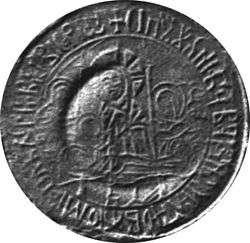Visarion, Metropolitan of Herzegovina
Visarion (Serbian Cyrillic: Висарион) was the Metropolitan of Herzegovina between 1590 and 1602.
Metropolitan Visarion | |
|---|---|
| Metropolitan of Herzegovina | |
 Visarion's seal, dated 22 May 1596 | |
| Metropolis | Metropolitanate of Herzegovina |
| See | Trebinje |
| Installed | 1590 |
| Term ended | 1602 |
| Predecessor | Savatije Sokolović |
| Successor | Silvestar |
| Personal details | |
| Born | Unknown Sanjak of Herzegovina, Ottoman Empire |
| Died | Unknown |
| Nationality | Rum Millet |
| Denomination | Serbian Orthodox |
| Residence | Tvrdoš Monastery in Trebinje |
He was the ktitor of the Great Church of the Tvrdoš Monastery in Trebinje, where he was seated.[1]
Life
Rebel activity
The Banat Uprising (1594), in which the Serbs in Banat rose up against the Ottomans,[2] had been aided by Visarion and Metropolitan Rufim Njeguš of Cetinje.[3] The rebels' war flags with the icon of Saint Sava[4] had been consecrated by Serbian Patriarch Jovan Kantul.[5] Ottoman Grand Vizier Koca Sinan Pasha ordered the flag of Prophet Muhammad be brought to counter the Serb flag, as well as the sarcophagus and relics of Saint Sava located in the Mileševa monastery be brought by military convoy to Belgrade. Along the way, the Ottomans had people killed in their path so that the rebels in the woods would hear of it. The relics were publicly incinerated by the Ottomans on a pyre on the Vračar plateau, and the ashes scattered, on April 27, 1595.[4][5]
Among the Serbs, especially after the incineration of the relics of St. Sava, the liberation movement met a large response. The center of action for Herzegovina was since 1596 the Tvrdoš Monastery in Trebinje, where Metropolitan Visarion was seated. Many of the Orthodox bishops called to Austria for help in liberating their lands.[6] In 1596 the liberation movement and fighting would spread into Ottoman Montenegro and the neighbouring tribes in Herzegovina, especially under influence of Metropolitan Visarion.[7] A Ragusan document from the beginning of 1596 claimed that the metropolitan and many Herzegovinian chieftains gathered in the Trebinje Monastery where they swore oath "to give up and donate 20,000 heroes to the [Austrian] emperors' light."[8] The rebels sought help or at least, symbolically, the Austrian flag as a proof of connection with Austria.[8] At the end of 1596, after the Himariote rebellion, the Serbs started to revolt.[6] The uprising broke out in Bjelopavlići, then spread to Drobnjaci, Nikšić, Piva and Gacko, and was led by vojvoda Grdan of Nikšić.[6] The uprising was short-lived, as the rebels were defeated at Gacko.[6] The rebels were forced to capitulate due to lack of foreign support.[9] After the failure of the uprising, many Herzegovinians moved to the Bay of Kotor and Dalmatia.[10] Grdan and Patriarch Jovan would continue to plan revolts against the Ottomans in the coming years.[7]
References
- Марица Шупут (1984). Српска архитектура у доба турске власти 1459-1690. Филозофски факултет, Институт за историју уметности.
Познато је да су друге цркве, које су биле поди- зане за седишта митрополита, биле управо митрополитске задужбине. Тако је херцеговачки митрополит Висарион био ктитор велике цркве манастира Тврдоша [11]. Из са- чуваних ...
- Rajko L. Veselinović (1966). (1219-1766). Udžbenik za IV razred srpskih pravoslavnih bogoslovija. (Yu 68-1914). Sv. Arh. Sinod Srpske pravoslavne crkve. pp. 70–71.
- Editions speciales. Naučno delo. 1971.
- Nikolaj Velimirović (January 1989). The Life of St. Sava. St. Vladimir's Seminary Press. p. 159. ISBN 978-0-88141-065-5.
- Mitja Velikonja (5 February 2003). Religious Separation and Political Intolerance in Bosnia-Herzegovina. Texas A&M University Press. pp. 75–. ISBN 978-1-58544-226-3.
- Ćorović 2001, Преокрет у држању Срба
- Istorisko društvo Bosne i Hercegovine (1959). Annuaire de la Société historique de Bosnie et Herzégovine. Istorisko društvo Bosne i Hercegovine.
из Дубровника из почетка 1596 тврди да су се многи херцего- вачки главари са митрополитом састали у требшьском манастиру и заклели »да Ье се дати и поклонити светлости импературови су 20 тисуЪа ]унака«. Устаници траже помоЬ или бар симболично аустриску заставу као доказ везе са Аустри]ом. Ускоро ^е дошло до ускочког осва^ан>а Клиса (8 IV 1596) што ]е изазвало силно узбзфеиье од Лике до Херцеговине. Ускоци су ако развили сво^е походе; на бедемима дубровачким ста^але су отсечене главе цоги- нулих харамбаша"). Шпанско-папска флота била ^е у Месини и очекивала наре1>еNoе за удар против турских обала3"). На новом збору у Требин>у владиха Висарион и главари упутали су Доминика да оде у Грац и Праг. Избавили су да чекану »заповест за устанак«; тада ]е Клис ]ош био ускочки. Из Граца ]е стигао агент Михо ЗлатариЬ те ...
- Trevor W. Harrison; Slobodan Drakulic (31 August 2011). Against Orthodoxy: Studies in Nationalism. UBC Press. pp. 99–. ISBN 978-0-7748-2096-7.
- Jovan Cvijić (1987). Sabrana dela: Balkansko Poluostrvo. Srpska akademija nauka i umetnosti. p. 145.